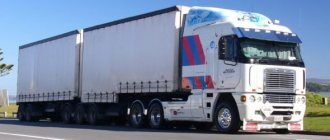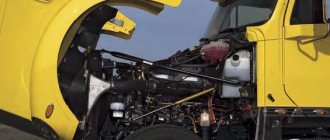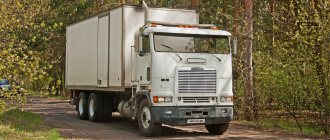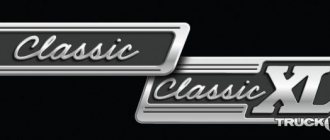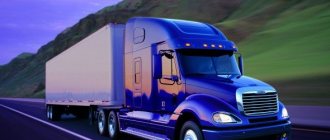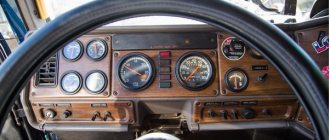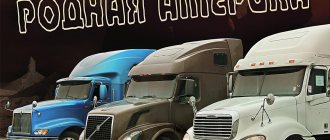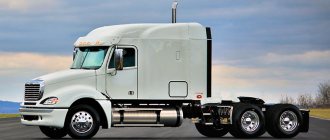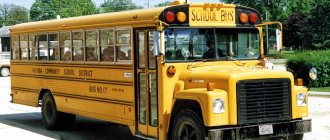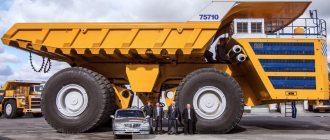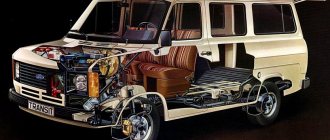Translated from English, the word “argosy” means “large merchant ship”. The Freightliner Argosy , with its tall, large over-engine cab, is your answer to on-highway long-haul trucks. Safe and reliable, the Freightliner Argosy offers unobstructed visibility and no engine tunnel for added space and comfort.
Front steering angles of up to 50 degrees, combined with an optimal 40-inch bumper-to-front axle distance for ideal weight transfer, allow the Argosy to maneuver in tight spaces such as road intersections and loading docks. Freightliner Argosy trucks focus on performance and maximizing payload without compromising driver comfort and safety.
Production
Fredliner Argosy's production years spanned just under a decade, ending official production in the United States in 2007. However, the end of Fredliner Argosy's journey in America is not the end of the road. Representative offices of Daimler AG in Australia, South Africa and New Zealand caught the wave and continue to assemble Argosy road liners regularly and with great enthusiasm. Affectionately nicknamed “Fred” or simply “Fedya” by Russian drivers, the truck has been presented on the domestic market since 2004. Basically, these are used Freudliner Argosy - used options that are popular among domestic truckers to this day, thanks to the optimal combination of convenience, safety and driving comfort.
Echoing the success of its fellow brand, the Freightliner FLA 9664 truck, which starred in the cult film “Terminator 2,” the new 2014 Freightliner Argosy played a major role in the blockbuster “Transformers 4: Age of Extinction.”
In 2014, Fredliner Argosy received a role in the final part of the famous blockbuster "Transformers".
In addition, Twins Custom Coaches (America's premier specialist in luxury truck restyling) has taken a serious interest in the used Fredliner Argosy, transforming the truck into a state-of-the-art motorhome for road-trip celebrities. Needless to say, Argosy, whose destiny is an endless, tedious and difficult road, managed to make not only his path interesting.
Cargoautoinfo. Freight transport in detail.
What do Dr. House, Coca-Cola and Optimus Prime from Transformers have in common? Of course, love for Freightliner tractors! It seems strange, but the trucks, which are terrifying in size, have forever been given an affectionate nickname: “Uncle Fred.”
They say about them: the cabin is a one-room apartment, the cross-country ability is on par, but don’t go into a metropolis with it. Freightliner Incorporated appeared almost 70 years ago and by 2005 had become the largest heavy-duty truck company in North America. On this occasion, the company itself modestly says: “We transport the majority of cargo on commercial vehicles in the continental United States.” It’s quite understandable, because since the 80s, the owners of Freightliner have been the “Mercedes” of Daimler AG, who are famous for their ability to calculate profits for many years in advance.
The first generation of Freds with an aluminum cab, 1939.
And in the early 30s, Consolidated Freightways was an ambitious transport company from Washington under the management of James Leland. He was obsessed with the idea of building a cabover truck with reduced curb weight. The first cabover vehicle, the CF-100 with an all-aluminum cab, was born in 1939 for its own needs. Its carrying capacity turned out to be 1 ton higher than any of its classmates - and the company began to receive orders from other companies.
True, production was briefly interrupted by the Second World War - but after its end it resumed with renewed vigor and in a new place, changing Salt Lake City to Portland and receiving its own name Freightliner. There, the future stars of “truck fights,” so beloved by Gregory House from the well-known series, roll off the assembly line to this day.
Tractor with an experimental ultra-high cab, 50s.
In general, in terms of innovations, the company of the inventor Leland gave a head start to anyone: even at the beginning of its activity, Conso Freightliner Lines is trying to use aluminum for brake pads, the interior lining of vans and in suspension components, and is also for the first time equipping the floor with corrugated aluminum with air ducts.
This contributed to a longer retention of cold, which ensured air circulation and ventilation. In general, this material, as well as the shape of the cabin in the form of a bubble with a nameplate on the radiator, have long become symbols of Freightliner.
Already in the late forties, cars had many functional features, such as an adjustable Bostrom chair or a tachometer that recorded all readings. At the same time, production partner Hyster required the company to install a 10-speed transmission on the model with a 19.5-inch driveline, and now the trucks they were producing could easily pull a 35-foot trailer. The innovative company attracted the attention of the “grands”, and in 1951 it came under the control of the large all-American White Trucks Company, which made it possible to take advantage of an extensive network of dealers and dramatically increase sales.
Freightliner CF is a former Ford Cargo that was inherited with the company.
By the middle of the twentieth century, production volume increased to 100 cars per year. After 10 years, another zero is added to this figure.
In 1973 the time of convenience comes. It is to alleviate long, monotonous days behind the wheel that the new Freightliner Conventional is being released, making the company even more popular and even more successful. And this at a time when oil prices in America have skyrocketed! Five years later, another plant for the production of main components and components opens, and then another enterprise on the East Coast. This could only mean one thing: Freightliner moved into the league of transnational concerns. And in the league, scary to say, of tractors as works of art: in 1976, a Freightliner with a sleeping compartment was exhibited at the Museum of History and Technology on the territory of the Smithsonian Institution.
The first result of cooperation with Daimler: FLC hooded cars had cabins from the light Mercedes LK series.
Remaining both a modest independent company and one of the leaders of the American auto industry, Freightliner falls under the wing of Daimler, led by the cheerful mustachioed Dieter Zetsche. The Germans have been trying for a long time and, in general, unsuccessfully to sell their Mercedes trucks to the Americans, but they did not react to them in any way. In 1981, Daimler-Benz bought the Freightliner division from White, which was on the verge of bankruptcy. The agreement is simple: Daimler finances production, receiving in exchange Freightliner's engineering resources and the importance of the German company in the eyes of all of America.
Severe Duty 8×6 heavy duty tractor with sleeper compartment.
Freightliner's sales growth in the 1990s only strengthened the position of both companies. So much so that in 1992, Americans took first place in the American market in sales of 8th (heaviest) class tractors. In 1995, “Uncle Fred’s” wards additionally purchased a large stake in the plant, which produces custom frames and suspensions, and thus formed the Freightliner Custom Chassis Corporation in South Carolina.
The company's latest cabover, the Argosy tractor, operates in Australia.
Further acquisitions of Americans can be entered into a separate catalog: in 1997, an entire division producing heavy vehicles was bought from Ford and renamed the Sterling brand, and then the bus manufacturer Thomas Built Buses and the Canadian tractor manufacturer Western Star were completely acquired ( curiously, once belonged to the same White Trucks).
Freightliner makes trucks for any application, including custom trucks like this Condor with a lowered cab.
Actually, this is where the history of trucks moves from the “Then” era to the “Now” era. Freightliner is today by far the largest manufacturer of commercial transportation equipment in North America, with sales of 150 thousand vehicles per year. And even though now the head of the Autobots and the cult hero of the Transformers epic, Optimus Prime, has exchanged “Uncle Fred” for an 850-horsepower Peterbilt, but for all the boys in the world, huge tractors will forever remain a symbol of road romance, for movie fans - a means of transportation for dark personalities whose faces will never be seen. not visible due to the height of the cabin, and for truckers - a comfortable apartment on wheels for the longest journeys.
On request, third-party studios will even build a superjeep on the chassis of a medium-duty vehicle.
Specifications
| Brand | Freightliner |
| Model | Freightliner Argosy |
| Modification | Freightliner Argosy 15.0MT |
| Model year | 1998 |
| Body type | Tractor |
| Number of doors | 2 |
| Number of seats | 2 |
| Country of assembly | USA |
| Type of fuel | DT |
| Acceleration time to 100 km/h | – |
| Maximum speed | 90 km/h |
| Fuel consumption in the urban cycle | – |
| Fuel consumption on the highway | – |
| Combined fuel consumption | 42.0 l per 100 km |
| Power reserve | 2 143 km |
| Fuel costs per year (with a mileage of 100 km per day) | 728 175 ₽ |
| Transport tax * (Moscow) | 39 200 ₽ |
| OSAGO * (Moscow, age over 22 years, experience over 3 years) | 5 000 – 8 000 ₽ |
Freudliner Argosy has several versions: the rules are dictated by the specifics of the segment. Easy operating conditions do not always mean there is a choice. Thus, engines are supplied by three manufacturers: Cummins, Caterpillar and Detroit Diesel, producing various powers from 300 to 600 hp. With the Cummins badge, six-cylinder models Cummins 500/6 IL, Cummins 620/6 IL, Series 60 470/6 IL, Series 60 500/6 IL and Cummins 530/6 IL are installed on the tractor with the following specifications:
- Engine capacity – from 12.5 to 15 liters;
- Engine power – up to 628 hp. at 2100 rpm;
- Maximum torque is 2800Hm with the main rise in the range of 1100-1400 rpm.
The transmission is also impressive: Freightliner Argosy trucks are equipped with a modern 18-speed Eaton UltraShift Plus transmission. In other cases, the supplier is the Meritor brand (formerly Rockwell). The wheelbase is standard - 6x4, in new models - 8x4. The steering angle of the front wheels reaches 50 degrees, which, in combination with the center of the front axle, located a meter from the bumper, makes the Argosy both maneuverable and stable. There are two wheelbase options: 3950 and 4100 mm. There are also two fuel tanks: both are aluminum and hold 492 liters. The Fredliner has a combined suspension type - spring-pneumatic. The gross weight of the truck and trailers can exceed 60 tons, and as a unique addition to the Freightliner Argosy, a three-axle trailer with a length of 17 meters has been developed.
To demonstrate the power of the Fredliner Argosy tractor, engineers assembled a special structure of three trailers.
Engine
This model was equipped with Detroit Diesel engines, as well as Caterpillar engines with a capacity of 12.7 liters and 14.6 liters. The less powerful version has a performance of 370 hp. with a torque of 2100 Nm. The maximum speed of a car with such an engine is 115 km/h, and diesel fuel consumption does not exceed 38 liters.
As for the second option, in this case the power is already 460 hp. at the same torque. With this power unit you can only accelerate to 90 km/h, and fuel consumption will be slightly higher - 40 liters.
Transmission and chassis
The Freightliner Argosy road truck is equipped with a manual transmission. To increase safety, a collision avoidance system is installed, equipped with sensors that monitor the appearance of objects and other vehicles near the car.
The Freightliner Argosy long-range truck features a low-profile chassis with 259 cm wide drive axles, which increases the payload of the vehicle and also ensures its stability when driving. The front wheels can turn up to 50°, which also contributes to the maneuverability of the Freightliner Argosy.
| Drive unit | Rear |
| Gearbox type | Mechanical, 18 gears |
